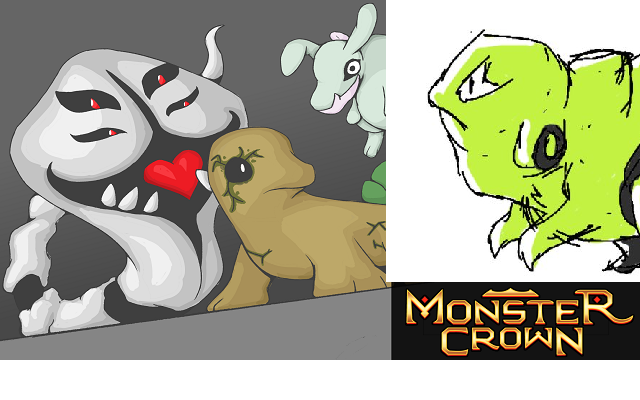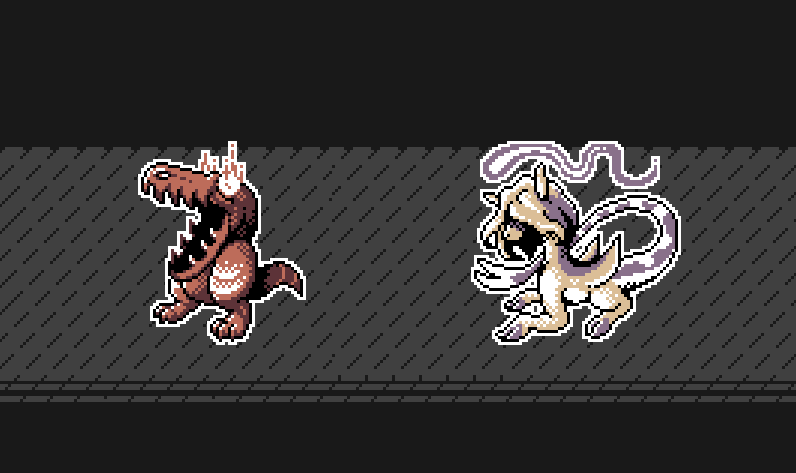Jason Walsh is the lead developer of the recently rebranded upcoming indie monster-raising RPG, Monster Crown. He took some time out of his busy development schedule to sit down and chat with me about what inspired the game and how some of its mechanics differ from similar games in the subgenre.

Erroll Maas: How did you come up with the name Crowns/ Monster Crown, and what were some other names you were considering?
Jason Walsh: When the Crowns project first began, the scope and ideas were much smaller than they are today, but one thing was always important — this was going to be a game about monsters that all wanted to be top dog, and it was going to have a story about characters that wanted “The Crown,” either literally, in a kingdom, or figuratively, in a power struggle. Crowns felt right, but as time went by, people kept saying, ‘This doesn’t tell me much about the game,’ or ‘What does Crowns mean?’ Obviously you can’t reply to those questions with a full knowledge drop on the motivations of the monster or characters — or well, you shouldn’t (I certainly more than once dropped a long-winded explanation). We even had some people say that they expected some Civilization-esque medieval game after hearing the title. It also wasn’t very searchable. People may hear of Crowns, go to look it up, and basically only find information about a British TV show! The concept of Crowns really stuck, though, and people had come to know us. From there, Monster Crown evolved quite naturally.
EM: What influenced the decision for Monster Crown to contain a darker narrative and lore than other games in the subgenre?
JW: Well, growing up with monster-catching games, I really took to them. Thoughts of them would invade my every waking hour — they lit up my imagination. Whether it was Pokemon, Dragon Warrior Monsters, Digimon, Telefang, or Monster Rancher, I was hooked on the concept of having these awesome monster companions and traveling with them. But there was some dark recess of my mind that also got sort of wrapped into it. I remember a very distinct dream where I was exploring and came across these very dark, vicious, nightmarish monsters. I found some secret in the game, and a world of horrors was unleashed. It scared me quite a bit, but as I grew older, it turned to a fascination. What dark secrets lie beyond those pixel walls? if you were to escape the cities, the routes, reach the deep parts of the world no one else had ever reached — what would you uncover? That can be an interesting question, and it’s one I’ve had in mind while building every corner of Monster Crown. Those willing to explore, to try unusual things, to let their imagination run amok — they’ll have plenty to discover in Monster Crown. Dark games like Shin Megami Tensei also greatly inspired me to develop the tone we’re looking for in Monster Crown.

EM: How many monsters will be in Monster Crown, and do you have a favorite?
JW: There will be 200 base monsters in Monster Crown. Each one has various genetic variations, and as you can see in the trailer, many will have totally unique transformations when a specific item is used on them — the Atomic Clock on Dracoyle ages him. The Antifungal on Laz turns him back into his original form. For those completionists out there, I know where you’re coming from. I have an urge to collect all the monsters too — you’ll have your hands quite full with Monster Crown, and I’m not talking about things like palette swaps. Personally, my favorite isn’t revealed yet — it’s Tanukrook. My teammate Shad seems to have channeled something straight out of that nightmare I mentioned earlier.
EM: Palette swaps do seem to be a common problem in monster-raising RPGs outside of Pokemon. Was it difficult to avoid palette swaps when creating monsters, or was it a goal since the game’s inception?
JW: Great question. Because our base idea was that the breeding system creates true crossbreeds, we knew right away that palettes were going to be a vital part of that system. Before we added genetic variations, we still knew the form would be based on the father, and the palette the mother. In that sort of system, a wild palette swap isn’t too appealing — you could just breed your monster to be whatever color you wished.

So inherently they wouldn’t be valuable to Tamers. Things like near-palette swaps, like the battle hammer-wielding variant of the Battle Rex (pictured above) in Dragon Warrior Monsters Joker can be SO cool! And originally we thought genetic variations could be slight changes, but ultimately we wanted to go all the way on our breeding mechanic, put all our chips down. For that reason, every monster sprite is handcrafted from scratch, including all variations.

EM: So you mentioned breeding, but Monster Crown also has a separate fusion mechanic. How do these mechanics differ, and why were both included?
JW: So we knew right off the bat that all sorts of people play monster-catching games. Some love very in-depth, thorough mechanics with a lot of control. They hate things like RNG — these are the Monster Scientists! I love what they manage to pull off and accomplish. But there is another group that enjoys more casual play. They like when things flow along smoothly and quickly. So with both of these people in mind, we knew we had to include a way to control the pace of the game to suit your individual tastes.
Personally I’m a bit of a Scientist — I love the breeding system. You get so much control, you get to keep both parents, but your offspring monster starts as a baby — you have to raise it up!
But Fusion exists for people that don’t want to wait around to hatch eggs, they don’t want to level up a baby to meet their mid-game team’s level, and they don’t mind losing the parents. For that reason, we added the fusion mechanic, letting people choose how rushed they are, how methodical they want to be. Whenever we can, we give options so people can play the game the way they enjoy most.

EM: In addition to breeding and fusion, to obtain wild monsters the player can offer them contracts. Why was this the chosen method rather than favorite food or another alternative?
JW: Monsters in our world share the temperament of a wild beast, but they are a little wiser. Offering a legal contract to a ,onster is pretty funny, but when you think about it, why does a wild beast want to join you? What do you have to offer? Monsters don’t care to be your friends, and they don’t like you very much. Offering a contract is a symbolic gesture; it means “Come with me, help me pursue my goals, and I will train you, and one day return you to your environment infinitely stronger than you stand today.” These monsters are playing the long game. They may struggle in their environment, but a promise to one day be the alpha, well, that’s exactly what they’re after. For this reason, there’s an entire city on Crown Island, Appenton, where young hopefuls study and perfect the art of writing contracts that are viable to both human and monster, and easily understood.

EM: It can be assumed that monsters will be of different types and have strengths and weaknesses to others. What are some of these monster types, and how do they differ from the types we’ve seen in other games?
JW: Our types are closer to personalities than physical types. This is quite a departure from other games in the genre. The types are Vicious, the blood thirsty sadists; the Brutes, which wield huge physical strength and act fairly arrogantly; the Will types, which are like calm, sturdy tanks; the Relentless, ones that refuse to quit with high endurance; and finally, the Unstable, the ones about to fall apart at the seams that act erratically. When you breed a Brute with Laz, you get a Laz that is bursting at the seams with strength. When you breed a Vicious type with a Teedon, you get one that looks like it might try to stab you in the back. Because of this, we’re able to design each monster as if it is bursting at the seams with its personality.

EM: The stockpiling mechanic encourages players to switch monsters of the same type in order to create a chain and boost the strength of their following attacks. What helped influence this idea?
JW: Well, in other games you can switch to another monster in your party. It takes time, you often take a hit, but you weigh the cost to the benefits of getting a type advantage.We wanted to expand on that, and we really start thinking of it from an outside perspective. How does it work? How do you switch the monster? We started trying to imagine it if we were tamers in-universe. Now if you recall, our monsters are very wild and mean — taming them to the degree that they obey direct, specific, and prompt commands to swap mid battle would take a high level of mastery over these wild beasts. They’d make a Lion Tamer look like a joke! So having this high level of team synergy builds energy, and it’s unleashed when you finally do attack. Of course, if you mess up, you can lose all your built-up stockpile without getting to use its power. Depending on the level of stockpile you’ve built, you’ll gain buffs or inflict debuffs. Depending on the foe, a building 2 stockpile before attack might be just what the doctor ordered. Against another, you might find that if you can’t hit a full stockpile gauge, it’s not worth it against this particular enemy. It’ll always be risk-reward, and we’re looking forward to the mind games people play against each other in online battling as well. Also, there is a secret additional stockpile level you can unlock as you play through the game. Anyone with the skill to reach that level may be rewarded … in “transformative” ways….

EM: Last question, is there some time we can expect a possible release date or release window, and will it be exclusive to PC?
JW: Well, we’re launching a Kickstarter on April 10th, so we’ll have a clearer picture then, but as of right now, we’re shooting for a February 2019 release. Of course we’re going to work hard to try to get it out even sooner. We do want to leave plenty of time for very thorough testing of both the game and the online battling and trading. It will launch on PC, Android, and iOS. I’m also going to do everything in my power to get it on the Switch and Vita, but that involves other parties as well, so I’m not able to promise anything at this moment.
I thanked Jason for taking the time out of his day to chat with me. Monster Crown is currently in development. An early demo of the game, Crowns Frostbite, is available for download on PC. You can follow Jason on Twitter as well as the Monster Crown Twitter, Facebook, subreddit, and website.









Published: Feb 15, 2018 09:47 am